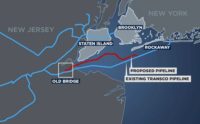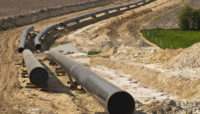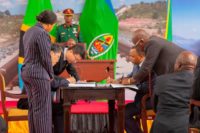
Tanzania has stepped up the pace for building a $1-billion natural-gas pipeline, accelerating the project’s target completion date to December 2012 from the initial March 2013 goal.
The 532-kilometer pipeline project is part of Tanzania’s plan to scale up investment in natural gas so that the country can tackle its acute shortage of electric power.
The pipeline will connect the natural-gas fields of Mnazi Bay and Songo Songo Island—the gas reserves of which are estimated at 10 trillion cu ft—to Dar es Salaam, the country’s commercial hub.
Tanzania is pushing up the project’s completion date to ensure it can meet its current electricity demand of 1,600 MW at any given time. The government’s current production is only 1,000 MW.
Energy and Minerals Minister William Ngeleja said in October that, upon completion, the project would produce 784 million standard cu ft of gas per day, which could generate 3,900 MW of electricity.
The project, carried out jointly by China National Petroleum Corp. (CNPC) and Tanzania Petroleum Development Corp., received a major boost in October when China signed a loan agreement with Tanzania for the project’s $1-billion cost.
The pipeline will be constructed in two phases. In the first stretch, a 609.6-millimeter-diameter pipeline will extend 25 km and link Songo Songo and Somanga Funga.
Then, the pipeline will be joined to a 914.4-mm-dia pipeline from Somanga Funga to Dar es Salaam, a distance of 207 km.
Phase two involves building a 914-mm-dia pipeline connecting Mnazi Bay with Somanga Funga, 285 km away.
At present, natural gas is transported through a 304.8-mm-dia pipeline from Songo Songo to Somanga Funga, where it is connected to a 406.4-mm-dia pipeline running to Dar es Salaam.
This existing pipeline is owned by Songas, a public-private consortium that holds an interest in the Mnazi Bay and Songo Songo Island gas fields. The fields are operated by Wentworth Resources Ltd., Dar es Salaam; Paris-based Maurel et Prom; Cove Energy PLC, London; and Orca Exploration Group Inc., whose operating office is in Dar es Salaam.
The coated pipeline in both phases will be buried one meter deep. Its diameter varies from 10 mm to 14.3 mm, according to an initial design by Tanzania Petroleum Development Corp., a state firm.
Ngeleja said that analysts from Tanzania’s Ardhi University have started carrying out an environmental and social-impact study in the areas through which the pipeline will run.




Post a comment to this article
Report Abusive Comment